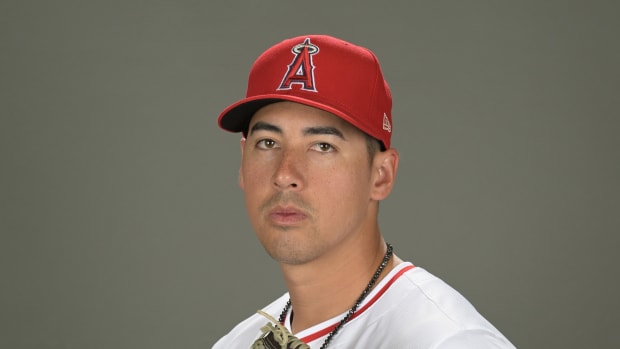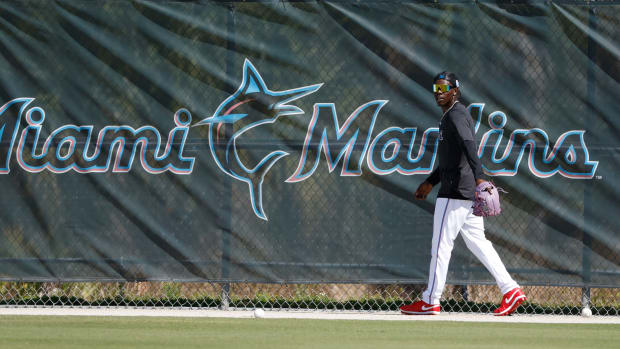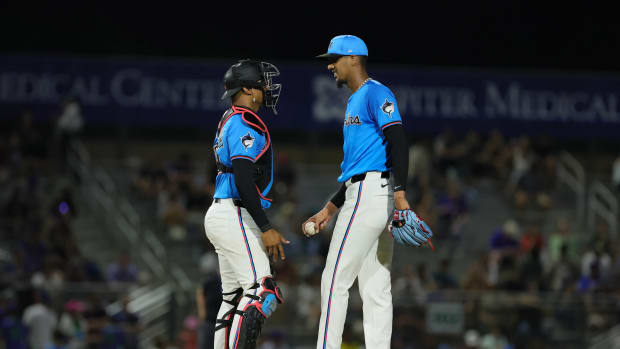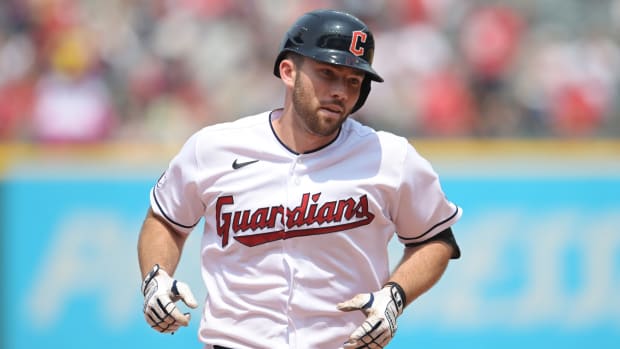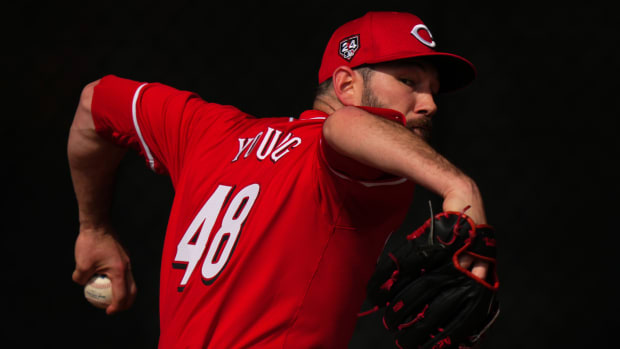Breaking Down the 2018 Hall of Fame Voting and What it Means for the Future
It's a quartet for Cooperstown! For the second time in four years but just the fourth time in the 82-year electoral history of the Baseball Hall of Fame, the Baseball Writers Association of America has elected a four-man class. In the results announced by Hall president Jeff Idelson on Wednesday evening, first-year candidates Chipper Jones and Jim Thome, second-year candidate Vladimir Guerrero and third-year candidate Trevor Hoffman all received at least 75% of the 422 ballots cast—and those ballots were packed fuller than ever. The quartet will join Jack Morris and Alan Trammell, the two candidates elected by the Modern Baseball Era Committee in December, in being inducted on July 29 in Cooperstown, New York.
What follows here are four quick thoughts about the election results, as well as the results themselves. As in years past, I'll have candidate-by-candidate coverage and a look at the next five years of voting over the next few days.
The Fourth Quartet and the Fifth Wheel
Jones led the 33-candidate slate by receiving 97.2% of the vote. His was the 11th-highest share in history, just 0.04% behind longtime teammate Greg Maddux; he was left off only 12 ballots. Guerrero, who missed election last year by just 15 votes, set a record for a second-year candidate with 92.9%, surpassing Roberto Alomar (90.0% in 2011). He joined Barry Larkin as the only modern candidates (since 1966, when the writers returned to annual voting) to gain at least 20 points from the previous year while crossing the 75% threshold, and even exceeded the vote share of Thome (89.8%).
Based upon the 248 ballots revealed prior to the announcement via Ryan Thibodaux's indispensible Ballot Tracker, Jones, Thome and Guerrero were all locks to be elected. The real suspense for this year's election lay in the outcomes for Hoffman, who missed by just five votes last year and had tracked at 79.1% on the published ballots, and ninth-year candidate Edgar Martinez, who had tracked at 77.5% but had been above 80%, and with a higher share than Hoffman, as late as Monday night. Based on the Tracker data, analyst Jason Sardell’s probabilistic forecast gave Martinez a 12% chance of election on Monday, which would have produced the first electoral quintet since the inaugural one in 1936 (Ty Cobb, Walter Johnson, Christy Mathewson, Babe Ruth and Honus Wagner). By late Wednesday, that chance had dropped to 3%.
As had been the case in the past two years, Hoffman's support on the unpublished ballots was similar to that on the published ones, while Martinez's fell considerably. The former, just the sixth reliever ever elected, received 79.9% in the actual voting, while the latter, who would be the first player elected after spending more than 60% of his career as a designated hitter, received 70.4%, missing by just 20 votes. He'll be the top returning candidate next year, his 10th and final one on the ballot.
While Wednesday's results may have been a disappointment for Martinez and his supporters, it's remarkable in the context of his having received just 27.0% as recently as 2015. The wider acceptance of analytics among voters, testimony from Hall of Famers Pedro Martinez and Randy Johnson as well as next year's top candidate, Mariano Rivera—all of whom called Martinez the toughest hitter they ever faced—and a heavy push from the Mariners, with whom Martinez spent the entirety of his 18-year major league career, have all helped to pave the way for his probable enshrinement. How probable? Since 1966: 19 out of 20 candidates who received at least 70% and had eligibility remaining were elected the following year, with Jim Bunning the exception; he was elected nine years later by the Veterans Committee.
The Big Nine
Four other candidates received at least 50% of the vote, a level strongly indicative of future election, namely fifth-year candidate Mike Mussina (63.5%) and sixth-year candidates Roger Clemens (57.3%), Barry Bonds (56.4%) and Curt Schilling (51.2%). The total of nine candidates receiving at least 50% of the vote matches those of last year and 1947, which perhaps not coincidentally was the first of the three other times the writers elected four players in one year, namely Mickey Cochrane, Frankie Frisch, Lefty Grove and Carl Hubbell. The additional quartets were elected in 1955 (Joe DiMaggio, Gabby Hartnett, Ted Lyons and Dazzy Vance) and 2015 (Craig Biggio, Randy Johnson, Pedro Martinez and John Smoltz).
Mussina is now reasonably well positioned for 2019, though with Martinez returning, and with Rivera and the late Roy Halladay as the top newcomers, it will take yet another quartet to squeeze all four into Cooperstown at once. Schilling, who dipped from 52.3% in 2016 to 45.0% last year in the wake of his inflammatory comments on social media, managed to regain most of his momentum.
Bonds and Clemens each gained about three percentage points despite the Hall of Fame's unprecedented plea—in the form of vice chairman Joe Morgan's letter from a Hall email address—not to elect candidates linked to performance-enhancing drugs. To get to 75% by 2022, their final year of eligibility, the pair will need to maintain similar levels of support from first-time voters (24 out of 26 for Clemens over the past two years, 23 out of 26 for Bonds) while older voters age out of the electorate. On that subject, it’s worth noting that they improved on the ballots not published prior to the announcement (a very rough proxy for older voters), with Clemens gaining 4.6% (from 42.5% to 47.1%) and Bonds 4.4% (from 40.4% to 44.8%).
Smaller Electorate, Bigger Ballots
The 422 ballots cast was 20 fewer than last year, and made for the smallest electorate since 1987, when just 413 ballots were cast. That's primarily a consequence of the Hall's 2015 decision to cull voters more than 10 years removed from active coverage, which took the vote away from roughly 100 writers. Industry contraction in the form of disappearing newspaper jobs and the dreaded pivot to video from online outlets has probably trimmed those rolls as well.
As has been the trend in recent years, however, the voters were particularly generous. In fact they broke their post-1966 record, set in 2015, in terms of votes per ballot, and nearly did so when it came to the percentage of writers using all 10 slots:
YEAR | ALL 10 | AVG PER BALLOT |
2013 | 22% | 6.60 |
2014 | 50% | 8.39 |
2015 | 51% | 8.42 |
2016 | 42% | 7.95 |
2017 | 45% | 8.17 |
2018 | 50% | 8.46 |
The 2013 ballot produced a shutout, as voters grappled with how to handle a new wave of PED-linked candidates (Sammy Sosa and Mike Piazza as well as Bonds and Clemens) and the most stacked ballot in modern history in terms of traditional and advanced statistical markers (300, 400 or 500 homers, 50 WAR, etc). Since then the voters have elected a total of 16 players, surpassing the 13 from 1951-55 and ’52-56 as the highest for any five-year period.
Minimal Down-Ballot Suspense
Only three of the other 17 first-year candidates besides Jones and Thome received at least 5% of the vote and thus retained eligibility for 2019, namely Omar Vizquel (37.0%), Scott Rolen (10.2%) and Andruw Jones (7.3%), the last two of whom were the subject of much Tracker tracking in the weeks and days leading up to Wednesday's announcement. Johan Santana (2.4%), Jamie Moyer (2.4%) and Johnny Damon (1.9%) were the only other first-year players who finished above 1%, but all join the ranks of the One-and-Dones. Assuming no change in the voting rules, they won’t even be eligible for consideration for the Today’s Game Era Committee ballot until 2028, when their 10-year eligibility window would have expired.
Among the other holdovers, eighth-year candidate Larry Walker (34.1%) blew past his previous high (22.9%, set in 2012) and gained 12.2 points relative to last year, making his gain the second-largest behind that of Guerrero (Martinez, at 11.8 points, was third). Of the other holdovers—Fred McGriff, Manny Ramirez, Jeff Kent, Gary Sheffield, Billy Wagner and Sammy Sosa—all were within a couple of points relative to the 2017 voting.
The Full Results
name | Years on Ballot | 2018 Votes | Percent |
Chipper Jones | 1 | 410 | 97.2% |
Vladimir Guerrero | 2 | 392 | 92.9% |
Jim Thome | 1 | 379 | 89.8% |
Trevor Hoffman | 3 | 337 | 79.9% |
Edgar Martinez | 9 | 297 | 70.4% |
Mike Mussina | 5 | 268 | 63.5% |
Roger Clemens | 6 | 242 | 57.3% |
Barry Bonds | 6 | 238 | 56.4% |
Curt Schilling | 6 | 216 | 51.2% |
Omar Vizquel | 1 | 156 | 37.0% |
Larry Walker | 8 | 144 | 34.1% |
Fred McGriff | 9 | 98 | 23.2% |
Manny Ramirez | 2 | 93 | 22.0% |
Jeff Kent | 5 | 61 | 14.5% |
Gary Sheffield | 4 | 47 | 11.1% |
Billy Wagner | 2 | 47 | 11.1% |
Scott Rolen | 1 | 43 | 10.2% |
Sammy Sosa | 6 | 33 | 7.8% |
Andruw Jones | 1 | 31 | 7.3% |
Jamie Moyer-x | 1 | 10 | 2.4% |
Johan Santana-x | 1 | 10 | 2.4% |
Johnny Damon-x | 1 | 8 | 1.9% |
Hideki Matsui-x | 1 | 4 | 0.9% |
Chris Carpenter-x | 1 | 2 | 0.5% |
Kerry Wood-x | 1 | 2 | 0.5% |
Livan Hernandez-x | 1 | 1 | 0.2% |
Carlos Lee-x | 1 | 1 | 0.2% |
Olrando Hudson-x | 1 | 0 | 0.0% |
Aubrey Huff-x | 1 | 0 | 0.0% |
Jason Isringhausen-x | 1 | 0 | 0.0% |
Brad Lidge-x | 1 | 0 | 0.0% |
Kevin Millwood-x | 1 | 0 | 0.0% |
Carlos Zambrano-x | 1 | 0 | 0.0% |
x-eliminated from future BBWAA ballots.






























